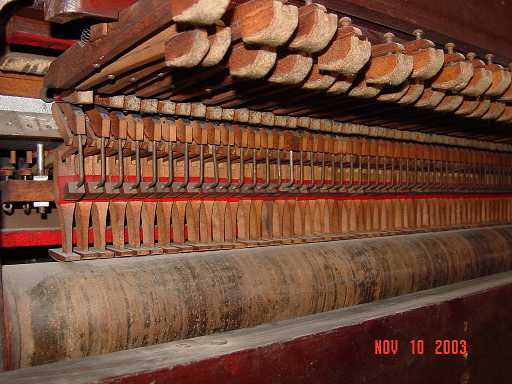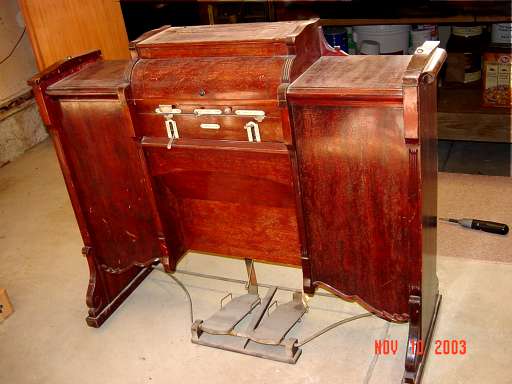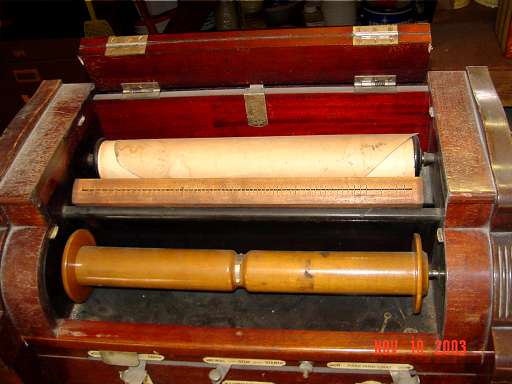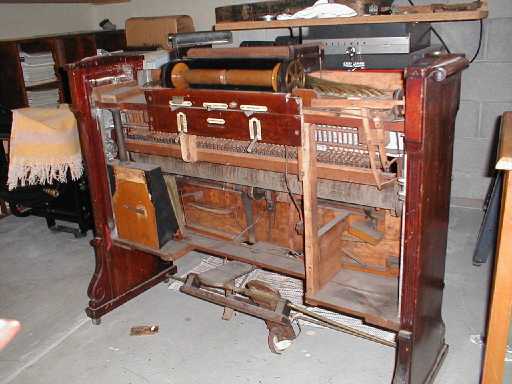| You Are Not Logged In | Login/Get New Account |
|
Please Log In. Accounts are free!
Logged In users are granted additional features including a more current version of the Archives and a simplified process for submitting articles. |
|
MMD
 Gallery
Gallery
 Pictures
Pictures
 PwrRoller
PwrRoller
 lyraphone1.htm
lyraphone1.htm
|
|
made by the Smith Lyraphone Company of Baltimore. Maryland, USA photos courtesy Ray Fairfield
The surface of the cylinder (the power roller) is lined with cork and is approximately 5 inches [12.7 cm] in diameter and about 3 feet [91 cm] long. The cylinder is rotating, powered by the foot pedals. Little "feet" with a friction sole are positioned just above the cork cylinder, one "shoe" for each of the 65 notes. The shoes are attached to individual linkages that pull down on the "fingers" that play the keys on the piano. The foot pedals operate in the normal way, but instead of directly actuating exhauster bellows, the pedals turn a drive shaft by way of a leather strap wrapped around the shaft. The shaft runs the width of the unit. Each half of the shaft has a mechanical overrunning clutch that transmits power when pressing down on the pedal but allows free rotation when the pedal returns up. Pedal return is through a round leather belt from a spring located underneath. One end of the drive shaft drives the small exhauster bellows and reservoir, which provides the vacuum for the tracker bar and (I assume) pouches. The other end of the drive shaft spins the cork-covered cylinder by way of a sprocket and a leather belt which has holes in it corresponding with the teeth on the sprocket. The music roll drive is via a clever power take-off at one end of the cork-covered roller. Linkages clutch the take-up spool during normal play, and lift that shaft and engage another during reroll. The music roll drive is via a clever wheel that contacts from the end face of the power roller. For faster music speed, the wheel is positioned further from the center. The patent date is stamped into the wood tracker bar: Nov. 13, 1900.
It plays a 65-note roll of approximately 13-1/4 inch [33.66 cm] width.
The roll drive is from the left side (the pin of the roll is flattened
on one side), while the right side pin is just a round pin. The tracker
bar "holes" are actually rectangular, being made by inserting spacers in
the long slot formed by the upper and lower rails of the tracker bar.
One Lyraphone music roll came with the mechanism. The width of the holes that play the notes does not vary throughout the scale. I surmise that the pneumatic chest is some sort of pouch system. When a note hole at the tracker bar is uncovered, a membrane pouch moves the "shoe" to touch the roller. Then the "shoe" is kicked out by the spinning roller, pushing down the finger that plays the piano key. The whole system is really pretty slick! Ray Fairfield
[back to Power Roller instruments]
04 December 2003 |
|
|
|
|
|
|
|
|
|
CONTACT FORM: Click HERE to write to the editor, or to post a message about Mechanical Musical Instruments to the MMD Unless otherwise noted, all opinions are those of the individual authors and may not represent those of the editors. Compilation copyright 1995-2026 by Jody Kravitz. Please read our Republication Policy before copying information from or creating links to this web site. Click HERE to contact the webmaster regarding problems with the website. |
|
|
||||||
|
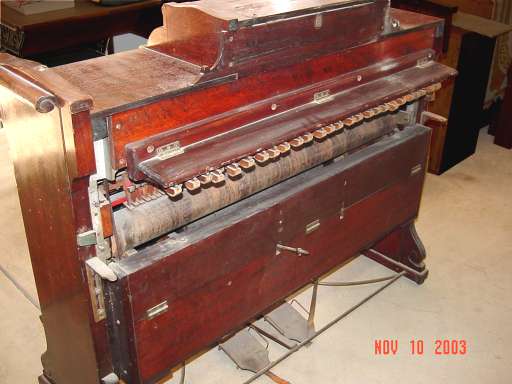 This
roll-playing device was made by the Smith Lyraphone Company of Baltimore.
Maryland, USA. The interesting thing is how it plays by a spinning
power roller.
This
roll-playing device was made by the Smith Lyraphone Company of Baltimore.
Maryland, USA. The interesting thing is how it plays by a spinning
power roller.
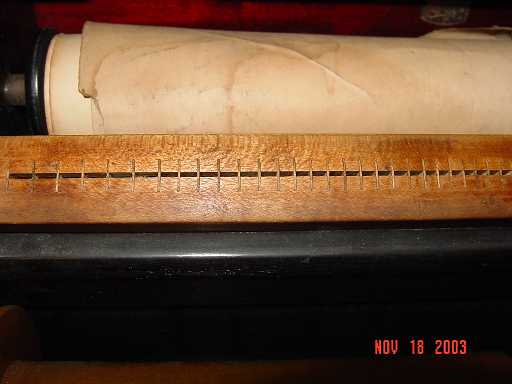 The
interesting thing about this tracker bar is that there are four distinct
(and different) hole widths. If the holes are numbered 1 through
65, beginning from the lowest bass note, then holes 1-6 and 65-59 are approximately
.276 inch [0.7 cm] pitch. Holes 7-12 and 58-53 are approximately
0.204 inch [0.52 cm] pitch. Holes 13-21 and 52-44 are approximately
0.182 inch [0.46 cm] pitch. The remaining holes 22-44 are approximately
0.164 inch [0.42 cm] pitch. [
The
interesting thing about this tracker bar is that there are four distinct
(and different) hole widths. If the holes are numbered 1 through
65, beginning from the lowest bass note, then holes 1-6 and 65-59 are approximately
.276 inch [0.7 cm] pitch. Holes 7-12 and 58-53 are approximately
0.204 inch [0.52 cm] pitch. Holes 13-21 and 52-44 are approximately
0.182 inch [0.46 cm] pitch. The remaining holes 22-44 are approximately
0.164 inch [0.42 cm] pitch. [